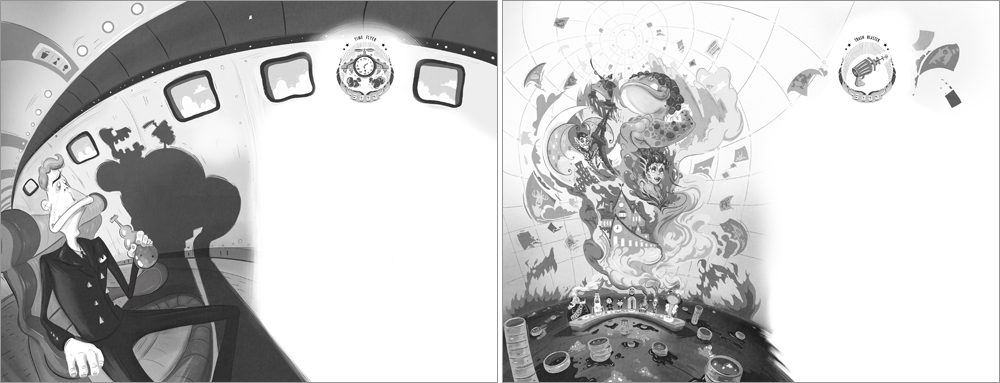When two children stumble into a secret department within an electronics factory, they discover employees with wings, tentacles, horns, and even one with three heads. The offbeat cast of The Creature Department (Razorbill), a middle-grade novel due out November 5, sprang from the imaginations of author Robert Paul Weston and a team of artists, headed up by designer Zack Lydon, at visual effects company Framestore. This is the first literary collaboration for the studio, which uses artistic talent and technology to create images for multiple platforms.
Weston, whose earlier work includes Zorgamazoo, a novel in rhyme that was an E.B. White Read-Aloud honoree, and Dust City, an Edgar Allan Poe Award nominee, said that The Creature Department grew out of a conversation he had with Ben Schrank, Razorbill’s president and publisher. “We were talking about ideas for a book, and about things we liked as kids, namely crazy inventions and strange creatures,” he recalled. “And then I thought about the idea of strange creatures making crazy contraptions, and from there it ballooned in a number of different directions.”
The history of a real-life electronics company also provided inspiration. “Sharp’s very first product was the mechanical pencil, and the idea that they would go on to become a large global electronics producer after beginning with a pencil intrigued me,” said Weston. “I began thinking, ‘What if the reason that they were able to make a leap that seems so miraculous is that there are strange creatures working in secret making these contraptions?’ So that gave me the premise.” Schrank was immediately drawn to Weston’s idea, and, he recalled, “We knew we wanted to do something special with this book.”
Familiar with Framestore’s work – in addition to creating the Geico gecko and the Coca-Cola polar bears, the studio contributed visual effects to numerous book-inspired movies, including the Harry Potter films, Where the Wild Things Are, and The Golden Compass, for which it won an Academy Award – Schrank brought the studio on board to create digital art for The Creature Department and work closely with Weston to develop the novel visually.
“Initially I wrote the framework, with descriptions of the plot and the characters and contraptions they invent,” said Weston. “And the team at Framework would come back to me with feedback about what they felt would work visually or not. It was definitely a dialogue, and I changed some of the words according to what they were drawing. The art that Zack and the others came up with was amazing. I’d never seen anything quite like it.”
Bringing Creatures to Life on Page and Screen
Lydon, a 2012 graduate of New York City’s School of Visual Art’s computer art program, and a self-described book lover and longtime fan of monsters, was thrilled to be involved in the project – which essentially meant founding Framestore’s very own creature department. “The first thing I did on the book was thumbnail a sketch of what the cover might look like, and that ended up being the jumping-off point,” he said.
As the collaboration got underway, Lydon perused Weston’s earlier books to, as he explained, “get a taste of his sense of humor and flavor.” He was impressed with the author’s portrayal of the freewheeling cast of creatures that populate the novel. “Rob’s descriptions gave a real feel of the characters and their motivations,” he said. “He was always very imaginative, and was open to pretty much anything I added as I put my own sense of humor into the details.”
Lydon’s inaugural book project was a departure for the artist in that the images he created were stationary. “I didn’t have to worry about making anything move, which is kind of a relief for an animator,” he said. “I could make things more detailed and decorated, but it would have been cumbersome to think of making those images move. But my passion for animation translated to the book a bit as I set up scenes. I kept a sense of motion in mind – thinking about how things would have unfolded if they did move.”
 |
Lydon's illustrations opening two of the novel's chapters. Click image to see a larger version. |
Lydon, who is also spearheading the book’s animated trailer, emphasized that creating the art for the book was a group effort at Framestore. “I did the glow-in-the-dark book cover completely solo, but a lot of people in the design department jumped in to back me up with the interior art,” he said. “I had a lot of collaborators.” Colleagues Lydon credited for helping to color his illustrations or create spot art include Alex Barsky, Callum McKeveny, Dan Solomon, and Jesse Flores.
Schrank called The Creature Department’s illustrations “some of the most complicated line drawings I’ve ever seen in a kids’ book. Rob was able to talk to the group at Framestore throughout the process. They are artists who understand storytelling and know when to pull back and let the words tell the story.”
To promote the book, Framestore developed an interactive, 3-D animated version of one character, Gügor, that was unveiled at BEA and reprised at the recent New York Comic-Con. An amiable giant salamander who sports multicolored dreadlocks, a tartan loincloth, and a fur vest, Gügor also appears on the book’s Web site in videos, including one in which he has a spirited conversation with Lydon, whom he introduces as his “second father.” The creature makes a brief appearance in the forthcoming trailer, to be featured on the book’s Web site as of November 5, and will connect with readers during an upcoming Twitter chat via @PenguinKids.
Is Weston concerned that Gügor may be stealing his authorial thunder? Not even close, he said: “This 3-D character is probably a much better ambassador for the book than I am.”
The Creature Department by Robert Paul Weston, illustrated by Framestore. Razorbill, $16.99 Nov. ISBN 978-1-59514-685-4





